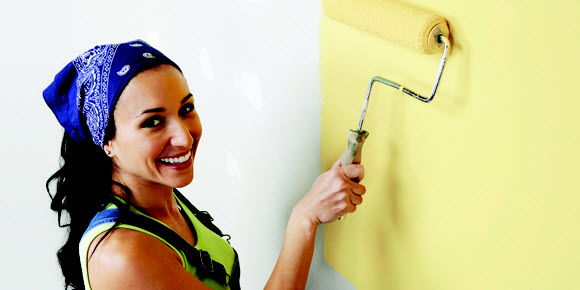When I write a column, I assume it will be read by men as they have been the traditional household DIYers. Times have changed, however, as evidenced by Toolbelt Diva, a TV program devoted to female DIYers, as well as articles in newspapers with headlines such as, Women are the New DIYers. With this in mind, I would like to pay homage to feminine DIYers by devoting this column to them.
The topic is whether it is better to paint a bedroom by yourself or pay to have the job done by a professional decorator and painter?
Here are some pros and cons for both sides.
DIY pros:
• Save money.
• Choose your own colours.
• No mark up on paint.
• Do it properly (I’ve seen some really sloppy paint jobs by so-called “professionals”).
DIY cons:
• Time and effort required.
• Cost of brushes, rollers, paint, etc.
• Problem selecting colour(s) if not confident in your aesthetic abilities.
Hiring decorator pros:
• Knowledgeable about colours and undertones.
• Large selection of colour chips from which to choose.
• Offer many colour options to complement your existing furniture, rugs, drapes, etc.
Hiring decorator cons:
• Charge $35 to $500 per hour, depending on reputation.
• Some individuals mark up paint prices, costing you more money.
• Time spent negotiating contract.
Hiring painter pros:
• Should complete the job quickly.
• Has own equipment.
• Knowledgeable about correct types of paints to apply to ceilings, walls and trims.
Hiring painter cons:
• To make a living, painters usually undertake multiple contracts, meaning your job may sit idle and take longer than expected to complete.
• Price may be much higher than quoted when job is completed. Expect to pay at least $35 per hour for a reputable, experienced painter who will not pad the final invoice.
• Finished job may not meet expectations, especially if you hire an inexpensive, fly-by-night company.
• Time spent negotiating contract should be considered.
If you decide on a DIY approach to painting, say, a 14-by-16-foot bedroom, including the ceiling, eight-foot walls, doors and trims, here are a few helpful tips:
• Check whether existing paint is oil- or water-based by wetting a cloth with rubbing alcohol and applying it to a discrete area. Oil (alkyd) paint will not be affected by alcohol, but water-based (latex) paint will be removed.
• Oil paint can be applied directly over alkyd or latex, but a primer is required when latex is applied over alkyd.
• Primers can be tinted if you are covering a light colour with a darker one. For example, a grey primer will prevent a light undertone from bleeding through darker paint, changing the overcoat’s actual colour.
• Before you begin painting, remove all the furniture from the room; otherwise, you will be constantly tripping over it.
• Cover the floor with a tough, polymer drop sheet that can be squeezed under baseboards.
• Holes in walls should be filled with spackle compound and sanded flush when dry.
• Use a damp cloth to clean walls, ceiling, doors, trims and baseboards.
• If you are working with water-based paint, apply at least one coat of latex primer to all areas that have an alkyd paint finish.
• A special alkyd paint is available for stipple ceilings that may crumble if a water-based product is applied to them.
• Cut in all corners with a coat of finish paint using a three-and-a-half-inch brush, then roll large areas, overlapping about 30 per cent. (Don’t buy cheap brushes or rollers. Your paint retailer will advise you on the best brush and roller to use on smooth and stippled surfaces.)
• Use masking tape and paper to protect trims and baseboards that will be left unpainted or painted a different colour. (To prevent “bleed,” push down hard on the tape with a rubber brayer. Alternatively, a machine that applies tape and paper automatically can be purchased or rented.)
• It is easier to paint doors by removing them. Knock out the hinge pins or unscrew hinges that do not have pins.
• Clean latex from rollers and brushes with warm water and a scrub brush or purchase a centrifugal spinner for about $15. Clean alkyd with paint thinner and a centrifugal spinner.
Assuming that you own a good stepladder or can borrow one, I estimate the cost of your DIY paint job to be approximately $300 for primer and finish paint, plus about $50 for incidentals like brushes, rollers and masking tape. With taxes included, you are looking at $400 and several hours of sweat equity to complete your masterpiece.
On the other hand, I estimate the cost of hiring professionals is at least two or three times that amount, not including work interruption, time spent negotiating contracts, poor workmanship and the possibility of a padded invoice.
Last word: I think DIY females have an advantage over their male counterparts when it comes to painting, as women have an inherent ability to see and appreciate tones and shades of colour. Men are either colour blind or uninterested in a chromatic world, unless the hue of a hockey jersey or beer label is the subject at hand.



